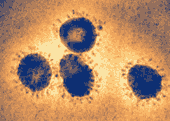SARS-CoV nsp7 and nsp8: Difference between revisions
| Line 11: | Line 11: | ||
<br> | <br> | ||
The discovery of the SARS-CoV has propelled extensive studies on its viral replication. Non-structural proteins 7 and 8 (nsp(7+8)) have been identified to be involved in the coronavirus replication and transcription. Furthermore, the interaction between nsp(7+8) is important for RNA-dependent RNA polymerase (RdRp) activities of the SARs-coronavirus genome. By understanding the structures of these non-structural proteins, scientists are one step closer to decipher the mechanism of SARS-CoV genome replication and may even use them to develop new strategies for the prevention or treatment of SARS in animals and humans. | The discovery of the SARS-CoV has propelled extensive studies on its viral replication. Non-structural proteins 7 and 8 (nsp(7+8)) have been identified to be involved in the coronavirus replication and transcription. Furthermore, the interaction between nsp(7+8) is important for RNA-dependent RNA polymerase (RdRp) activities of the SARs-coronavirus genome. By understanding the structures of these non-structural proteins, scientists are one step closer to decipher the mechanism of SARS-CoV genome replication and may even use them to develop new strategies for the prevention or treatment of SARS in animals and humans. | ||
Revision as of 05:04, 25 March 2013
Introduction
The outbreak of SARS in Hong Kong almost caused and pandemic and created a worldwide panic. From late 2002 to July 2003, there were about 8,273 cases and 775 deaths. People who are infected often have muscle pain, headache, fever as well as respiratory symptoms such as cough and pneumonia. The disease is known to infect older people with mortality rate the highest for those over 50 years old. Also known as severe acute respiratory syndrome, SARS has not been eradicated and can return to infect the human population. Since no antibiotics, antivirals, steroids, and therapies are known to be effective against this viral disease, it has become a top priority for the government and public health scientists around the world to identify and develop vaccines and medicine to prevent another outbreak.
Severe acute respiratory syndrome is caused by a SARS coronavirus (SARS-CoV). SARS-CoV is a positive strand RNA virus that causes respiratory and enteric disease. Viral replication of the coronavirus genome replication takes place in the cytoplasm. Infection by the coronavirus can alter cell cycle, transcription and translation pattern as well as induce apoptosis and inflammation. SARS-CoV was identified by a number of laboratories to be the main cause of SARS. In April 2003, Michael Smith Genome Sciences Centre, located in Vancouver, became the first lab in the world to sequence the coronavirus that causes SARS using samples from infected patients in Toronto. The mapping of the SARS-CoV is a step forward to fighting SARS. With this sequence, scientists can began to understand more about the coronavirus structure, function and genome replication as well as began antiviral research against SARS coronavirus.
The discovery of the SARS-CoV has propelled extensive studies on its viral replication. Non-structural proteins 7 and 8 (nsp(7+8)) have been identified to be involved in the coronavirus replication and transcription. Furthermore, the interaction between nsp(7+8) is important for RNA-dependent RNA polymerase (RdRp) activities of the SARs-coronavirus genome. By understanding the structures of these non-structural proteins, scientists are one step closer to decipher the mechanism of SARS-CoV genome replication and may even use them to develop new strategies for the prevention or treatment of SARS in animals and humans.
Section 1
Include some current research in each topic, with at least one figure showing data.
Section 2
Include some current research in each topic, with at least one figure showing data.
Section 3
Include some current research in each topic, with at least one figure showing data.
Conclusion
Overall paper length should be 3,000 words, with at least 3 figures.
References
Edited by (your name here), a student of Nora Sullivan in BIOL187S (Microbial Life) in The Keck Science Department of the Claremont Colleges Spring 2013.

